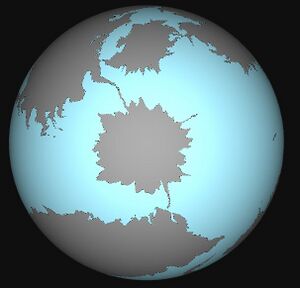Antartique: Difference between revisions
(Created page with "{{Infobox continent |title = Antartique |image = Antartique.JPG |area = |population = |density = |GDP_nomina...") |
No edit summary |
||
| Line 3: | Line 3: | ||
|image = Antartique.JPG | |image = Antartique.JPG | ||
|area = | |area = | ||
|population = | |population = 1,000-5,000 depending on season | ||
|density = | |density = | ||
|GDP_nominal = | |GDP_nominal = | ||
| Line 11: | Line 11: | ||
|ethnic_groups = | |ethnic_groups = | ||
|religions = | |religions = | ||
|demonym = | |demonym = Antartique | ||
|countries = | |countries = 0 | ||
|list_countries = | |list_countries = | ||
|dependencies = | |dependencies = | ||
Revision as of 03:51, 25 April 2020
 | |
| Population | 1,000-5,000 depending on season |
|---|---|
| Demonym | Antartique |
| Countries | 0 |
Antartique is the smallest and southern-most continent located on the planet of Iearth, straddled by the Toyana Ocean and the Samson Ocean. It contains the geographical South Pole, and is the least populated as well as least densely populated continent on the planet. About 98% of Antartique is covered by ice that averages 1.9 km (1.2 mi; 6,200 ft) in thickness. It is the coldest and driest continent, as most of Antartique is a polar desert, with annual precipitation of 200 mm (7.9 in) along the coast and far less inland. 80% of the world freshwater reserves are stored in the glacial areas of the continent.
Organisms native to the continent include many types of algae, bacteria, fungi, plants, and certain animals, such as penguins, seals and tardigrades.
The Coalition of Crown Albatross's 1976 Treaty of Drendarich prohibits military activities and mineral mining, prohibits nuclear explosions and nuclear waste disposal, supports scientific research, and protects the continent's ecology. Ongoing experiments are conducted by more than 4,000 scientists from many nations.
